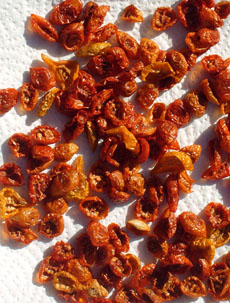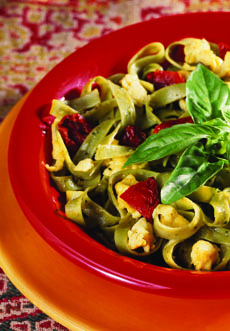TIP OF THE DAY: How To Use Sundried Tomatoes
 Sundried_tomatoes. Photo by Andrew Deacon | Wilimedia. |
Luscious, local vine-ripened tomatoes won’t be in our farmers markets for another month. So until their joyous arrival, we’re still making do with cherry tomatoes and sundried tomatoes.
One of our interns asked if sundried tomatoes had to be rinsed before eating, inspiring today’s tip. First, the answer is yes: Like mushrooms, sundried tomatoes should at least be brushed or wiped with a damp cloth. But the rest depends on the format of the tomatoes and how you plan to use them. If you rinse them in water they will plump up, but your recipe might have other instructions. WHAT ARE SUNDRIED TOMATOES? Sundried tomatoes (also spelled sun-dried) are ripe tomatoes that have been dried in the sun for 4-10 days. They keep their nutritional value, and provide tomato flavor when the fresh fruits* are not in season. As with other dried fruits (raisins, prunes), drying concentrates the flavor and makes it more intense. So compared to fresh tomatoes, fewer sundried tomatoes are needed in a recipe. *Yes, tomatoes are a fruit. Here’s the difference between fruits and vegetables. |
|
|
CREATING SUNDRIED TOMATOES
Most of the water evaporates in the drying process, creating a shelf-stable ingredient. No refrigeration is necessary, and the tomatoes remain soft and flavorful for months. It takes from 9 to 15 pounds of fresh tomatoes to make a single pound of sundried tomatoes. The tomatoes are typically pre-treated with the preservative sulfur dioxide to maintain their bright red color; otherwise they turn a blackish-red over time. Traditionally, sundried tomatoes are made from red plum tomatoes, but you can sometimes find yellow varieties. Sundried tomatoes can be purchased loose or packaged, dry or packed in olive oil. They are sold in paste and purée forms. |
||
|
HOW TO USE SUNDRIED TOMATOES You can use the tomatoes as is, or reconstitute them. Specific recipes will tell you what to do, but here are some general uses: Dry Sundried Tomatoes You can purchase sundried tomatoes already reconstituted in oil, but it’s more cost effective and flavorful to reconstitute your own. You control the quality of the oil, and can add basil, garlic cloves, jalapeño or other heat, oregano, rosemary, etc. (or use flavored olive oil). |
|
|
|
Soak the tomatoes in warm water, broth, wine or other cooking liquid to reconstitute. for 30 minutes until they are soft and pliable, then drain and pat dry (reserve the liquid to add flavor to stocks and sauces—if you’re not making anything immediately, freeze the liquid). To reconstitute the tomatoes in olive oil or other oil (we like a flavorful oil), cover them with the oil and refrigerate for 24 hours. You can add herbs or spices to the oil. Then drain the oil and use it for salad dressing or cooking oil. Once the tomatoes are reconstituted, use them within several days or cover then in olive oil and store in the fridge for up to two weeks. Be sure that the unused tomatoes are completely covered with oil, adding adding more oil as necessary—and planning to use the oil when the tomatoes are gone. Use sundried tomatoes anywhere you’d use fresh tomatoes, and even where you wouldn’t:
|
||



